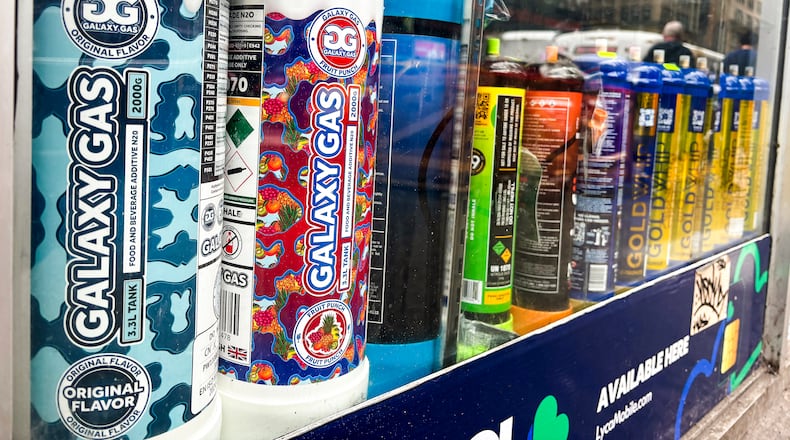Nitrous oxide may be nicknamed “laughing gas” but health and public safety officials say the potential dangers of misusing and abusing the substance are dead serious.
“It is dangerous, particularly in the long-term, chronic use, where you get complications,” said Dr. B. Patrick Murray, emergency medicine physician at Miami Valley Hospital and the associate program director of emergency medicine at Wright State University. “You could become hypoxic, you could have an anoxic brain injury, which is when you don’t have enough oxygen going to the brain and that causes permanent damage.”
“And while you are high, you might injure yourself and not even realize it,” he said.
Nitrous oxide is a sedative that has been used by physicians and dentists for more than 180 years, according to the Cleveland Clinic. The fast-acting gas, which is usually administered as an anesthetic through a mask or nosepiece in medical settings, wears off quickly, making it an ideal sedation option for short or minor procedures, the clinic said. Nitrous oxide also is commonly used in the culinary and automotive fields, which is why it is legal for retail purchase across Ohio and nearly all U.S. states.
But almost 13.1 million Americans 12 and older have used nitrous oxide or “whippits” recreationally at some point in their lives, says the 2023 National Survey on Drug Use and Health. Whippits (a slang term that’s also spelled whippets and whip-its) are small pressurized canisters containing nitrous oxide that are used in whipped cream dispensers. Other nicknames for nitrous oxide include “hippy crack,” “Nos” and “nitro.”
According to the survey, 2.9 million Americans 12 and older said they had used inhalants in the past year, which includes gases like nitrous oxide, but also nitrites (such as “poppers”), aerosols (like spray paints, computer keyboard cleaners) and solvents (paint thinners, glues, gasoline, shoe polish, felt-tip markers). About 564,000 young people ages 12 to 17 said they used inhalants within the last year (or 2.2% of this population), the survey found.
Nitrous oxide for a long time was commonly sold in balloons, plastic bags or small containers outside of raves, dance clubs, festivals and rock concerts, including shows for jam bands like Phish, the Grateful Dead and Widespread Panic.
A small cannister might contain 8 grams of nitrous oxide.
But nitrous oxide also is being sold at a variety of stores across the Miami Valley, state and nation in metal dispensers that contain multiple liters of the gas (which is hundreds or even a couple thousand grams of the substance).
A smoke shop in East Dayton sells GoldWhip and CrèmeMax nitrous oxide tanks that come in flavors like apple, watermelon, blueberry and strawberry.
A smoke shop in southeast Dayton sells Goo nitrous oxide products that come in banana and pink lemonade flavors. And a head shop in one of the city’s business districts sells LovelyMate and Galaxy Gas products.
These stores also sell other products with packaging that promises to get consumers intoxicated, like Delta-8 cannabis vapes and edibles and chocolate and gummy “hallucinogenic” mushrooms. Galaxy Gas and many similar nitrous oxide products also can be purchased from Amazon and other online retailers.
Manufacturers like CremeMax, GoldWhip and LovelyMate say on their websites that their products are meant for culinary purposes, like creating whipped cream, foams, mousses and flavor infusions for beverages and desserts.
But online videos show some social media influencers and content creators huffing the products to get high.
Inhaling nitrous oxide can make users feel euphoria, numbness, lightheaded and a sense of calmness or detachment.
The U.S. Food and Drug Administration earlier this year issued a warning that advised consumers not to inhale nitrous oxide from canisters, tanks or chargers.
“These products can result in serious adverse health effects, including death, when inhaled,” the FDA said. “Nitrous oxide canisters, tanks, and chargers may be sold under various product brand names online and at retailers, including smoke/vape shops and gas stations.”
Nitrous oxide highs are short-lived, lasting seconds to minutes, and users often huff or sniff the drug over and over again.
Substances that have “quick on, quick off” highs have greater potential to be addictive, said Dr. Alek Adkins, medical toxicologist at Nationwide Children’s Hospital in Columbus and the Central Ohio Poison Center
“There’s case reports of patients using hundreds of cannisters per day,” he said. “It has a really high abuse potential.”
Adkins said nitrous oxide’s recreational popularity has fluctuated over time, but it seems to be a hot commodity once again, probably because of how easy it is to get.
Adkins said chronic or acute use of nitrous oxide can lead to neurological problems and users sometimes are unsteady on their feet and struggle to walk or move and they can develop spasms.
Patients basically can wind up paralyzed from prolonged use of nitrous oxide, Adkins said, and there’s no guarantee that medical treatment will help people regain full function.
“One of the most dangerous things from long-term use is you can get this horrible, debilitating neuropathy, or nerve damage,” Adkins said.
Nitrous oxide replaces oxygen in the lungs, so users can potentially suffocate from inhalation, he said. He said sucking in the gas from high-pressure cannisters also can result in ruptured eardrums or larynx or trachea injuries.
Nitrous oxide use can cause a relative B12 deficiency, leading to anemia and a decreased white blood cell count, said Murray, with Miami Valley Hospital and Wright State University.
“For the anemia, you get short of breath, you get a lot of fatigue, you won’t have much energy,” he said. “For the low white blood cells, you are at more risk of infections.”
Neuropathy, which can result from long-term use of the gas, can affect people’s daily life, causing weakness, tingling sensations and a loss of coordination, Murray said. Users also are at risk of injuring themselves and not noticing the injuries due to the loss of sensation, he said.
Treatment can reverse the damage, but it’s not a “quick fix,” he said, adding that people have to stop inhaling nitrous oxide to recover, which can be tough since it is addictive.
About the Author



